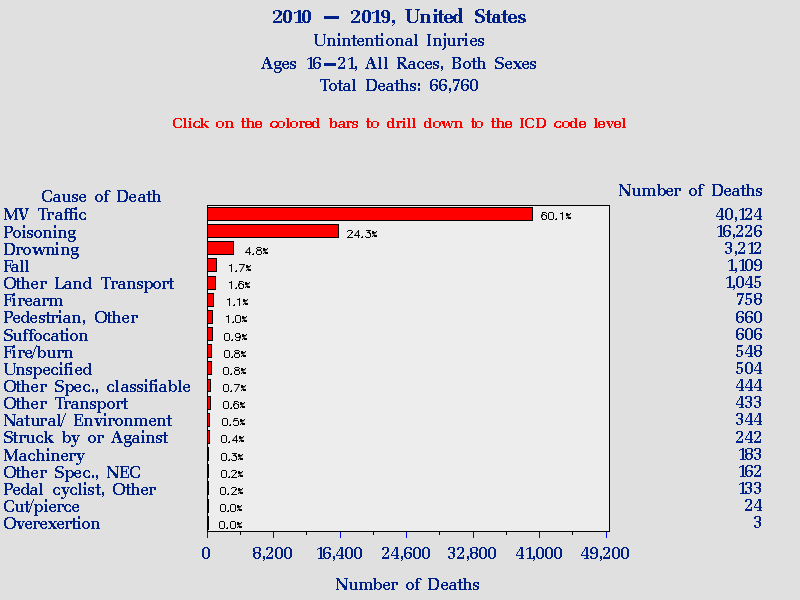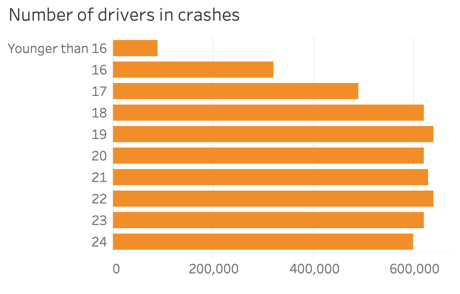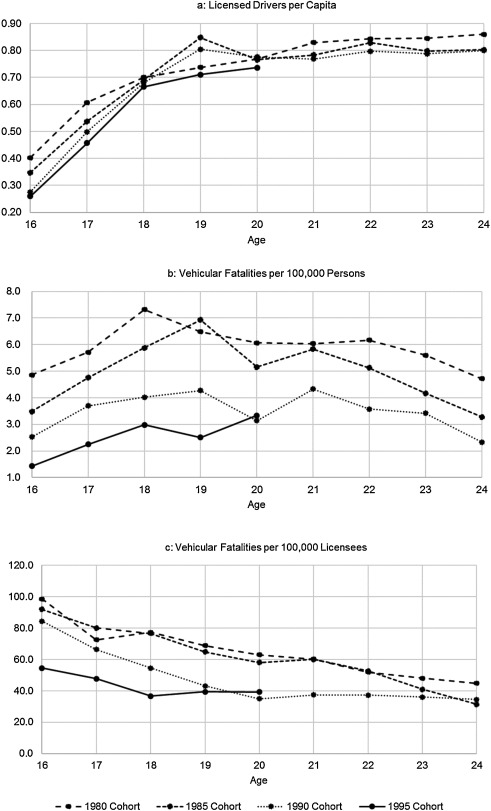Introduction
One of the promising possibilities of American social policy is to allow young people as young as sixteen to drive. This solution seems particularly interesting to discuss in view of the fact that the age of the majority of an American citizens is eighteen. In other words, with regard to the driver’s license, conditions are created in which an individual who is not yet of legal age and is not entirely responsible and competent for the actions he or she takes can drive a passenger car, potentially increasing the risk of accidental events on the road. In this sense, it is essential to note that the primary sources for the threat are the lack of developed critical thinking and the excessive impulsivity common to many adolescents. Thus, it is hypothesized that increasing the age of eligibility to drive from 16 to 18 would bring a number of critical benefits to American society. This research paper seeks to examine this issue in depth.
Statement of the Problem
When national governments decide on a country’s minimum driving age, they rely on many factors. Typically, the predictor for setting such an age limit is the individual’s ability to take responsibility for his or her actions. With regard to traffic accidents, the nature of such actions seems transparent: any accident, collision, or action resulting in the death of others is a necessary consequence for which there is a judicial and moral responsibility. In this sense, it is evident that the greater the responsibility one must bear for driving a vehicle, the greater the minimum age set for doing so. It is for this reason that the minimum age for driving a school bus within a state is 18 and increases to 21 for between states (Butterfield). However, for a passenger car, the initial driving age is set at 16, which means that any teenager who reaches that age can theoretically drive a car before they are of legal age.
The motivation for this decision seems transparent: as a rule, a young teenager is physically strong enough to drive as well as an eighteen- or twenty-one-year-old. At the same time, at this age, high school students usually move on to the last stage of secondary education, and along with it, begin to actively attend academic courses, tutors, sports sections, and creative unions. This expands the ecosystem of a high school student’s urban habitat, and so the use of personal transportation proves justified. In reality, however, driving at such an early age is a determinant of severe social problems.
The Dangers of Early Driving in the United States
A key argument for raising the minimum driving age for American teenagers to 18 is based on the physiological and psychological development of individuals. There is sufficient evidence to believe that at the age of sixteen, an adolescent’s brain is not yet fully formed, meaning that he or she is not old enough to be fully capable (Galván 855). In addition, studies demonstrate that adolescents are prone to take risky actions if they are watched by their peers (Smith et al. 284). In terms of driving, this has been tested in sixteen-year-olds’ reactions to a yellow traffic light when, instead of slowing down and waiting for the green light, young drivers surrounded by other teenagers accelerated. Obviously, this desire to take risks demonstratively creates potentially dangerous situations on the road. This is probably one of the reasons why inadequate driving is one of the leading causes of increased mortality among young people, as shown in Figure 1.

At the same time, teen drivers tend to be more impulsive and emotionally immature individuals. Studies describe that adolescent emotional intelligence continues to develop through the age of sixteen, which means these individuals are most likely to be expressive and reckless (Poon 4). On the road, this may generate a desire to exhibit dangerous driving in order to gain the respect of their peers. This can include driving into the oncoming lane, speeding, and performing life-threatening maneuvers, often resulting in death.
It is helpful to look at the available data from a different perspective. Driving at an early age becomes a problem not only for the health and life of the young driver but also for those around them. In particular, referring to Figure 2 makes it clear that drivers as young as 16 or 17 years old are often the perpetrators of car accidents. However, the overall population of young drivers is less than 4 percent of all licensed drivers in the United States, of the total number of crashes committed at a young age, 16- to 17-year-olds account for about 3.7 percent (National Safety Council). Thus, Figure 3 shows that among young drivers, 16- and 17-year-olds were most likely to be killed in crashes. In addition, national statistics show that in terms of passenger fatalities, the number of cases where the driver was young is about three times the number of cases where the driver was an adult (NHTSA; Alderman et al. 1). To put it another way, for children who are still minors, driving poses many risks, both in terms of their own health and in terms of social safety.



In addition, earlier driving is a predictor of serious illness and decreased physical activity. Sources indicate that most older patients who suffer from obesity and cardiovascular disease began driving at age sixteen (Pan 53). The automobile gives a person the freedom to move around the city and is a disadvantage to walking. As a result, teenagers give up healthy body time in favor of a faster, more comfortable ride. Although studies show that the number of accidents for juvenile drivers is rapidly decreasing, and fewer driving licenses are issued during the teenage years, the actual numbers still reflect a pessimistic agenda (Shults and Williams 181). To put it another way, the reasonableness of raising the minimum driving age is motivated by the existence of severe public danger from juvenile drivers.
Hence, raising the minimum driving age to eighteen could lead to obvious benefits stemming from the concerns of young drivers. Since by the age of majority, individuals appear to be more cognitively developed, have more stable social intelligence, and are able to take legal responsibility for their actions, this should reduce the number of threats. The statistics shown in the work reflected that the number of accidents at an older age is proportionally lower — accounting for the proportion, not the total number. Consequently, by setting the minimum driving age at eighteen, society is likely to qualitatively reduce the number of accidents and improve overall driving skills on the road.
Conclusion
To summarize, the minimum driving age is a socially important topic of discussion. There is a system in the United States in which even a juvenile who is not entirely responsible for his life can drive alone. Such conditions pose a threat to public safety, which affects the number of accidents, impaired driving, and lack of full judicial accountability for the actions committed. It is therefore proposed to raise the minimum driving age to eighteen, the age of American adulthood, since, at that age, the physiological and behavioral characteristics of the driver become those of adults.
Works Cited
Alderman, Elizabeth M., et al. “The Teen Driver.” Pediatrics, vol. 142, no. 4, 2018, pp. 1-14.
Butterfield, Chris. “How Old Must You Be to Drive a Bus? Is It 21 or 18?” CE Transport Law, Web.
Galván, Adriana. “Adolescent Brain Development and Contextual Influences: A Decade in Review.” Journal of Research on Adolescence, vol. 31, no. 4, 2021, pp. 843-869.
Gilpin, Gregory. “Teen Driver Licensure Provisions, Licensing, and Vehicular Fatalities.” Journal of Health Economics, vol. 66 2019, pp. 54-70.
National Safety Council. “Age of Driver.” Injury Facts, Web.
NHTSA. “National Statistics.” FARS, Web.
Pan, Xiaohong. Essays on Aging Americans’ Travel Preferences: Behavioral Survey Analyses. Columbia University, 2018.
Poon, Kean. “Hot and Cool Executive Functions in Adolescence: Development and Contributions to Important Developmental Outcomes.” Frontiers in Psychology, vol. 8, 2018, pp. 1-18.
Shults, Ruth A., and Allan F. Williams. “Trends in Teen Driver Licensure, Driving Patterns and Crash Involvement in the United States, 2006–2015.” Journal of Safety Research, vol. 62, 2017, pp. 181-184.
Smith, Ashley R., et al. ” Peers Influence Adolescent Reward Processing, but Not Response Inhibition.” Cognitive, Affective, & Behavioral Neuroscience, vol. 18, no. 2, 2018, pp. 284-295.
“Unintentional Injuries.” NCHS, Web.